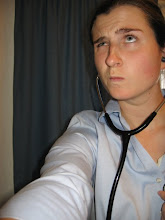Two experienced ER doctors, one right handed and one left handed, gave an introductory talk about sutures and demonstrated how to make a basic suture. Then they handed out a pig's foot to each student and we made a cut with a scalpel into the foot and then tried to suture the gash close again. It was really fun. It actually felt like we were in medical school.
 Ahhhh... Wilbur (or at least a pig that looks like Wilbur) the heroic star of the book, Charlotte's Web. The spider, Charlotte, works to save Wilbur from being butchered and eaten by writing phrases such as "Some Pig" in her web above Wilbur's pen. Little did Charlotte know that there was another use for Wilbur that had nothing to do with bacon for breakfast - suture workshop. I guess if Wilbur did have to die, we might as well use his feet for something. (Image from a Google image search).
Ahhhh... Wilbur (or at least a pig that looks like Wilbur) the heroic star of the book, Charlotte's Web. The spider, Charlotte, works to save Wilbur from being butchered and eaten by writing phrases such as "Some Pig" in her web above Wilbur's pen. Little did Charlotte know that there was another use for Wilbur that had nothing to do with bacon for breakfast - suture workshop. I guess if Wilbur did have to die, we might as well use his feet for something. (Image from a Google image search).Just in case you all are interested in learning a little bit more about suturing, I thought I would inform you of some of the basics that I was not fully aware of before last night. First of all, the suture needle is curved. This shape makes the circular movement of placing a suture easier to accomplish. Secondly, the suture needle does not have an eye, but the need is continuous with the suture thread. Thirdly, you don't hold the suture needle with your fingers, but in a medical version of mini-vice grips called hemostats or needle driver (or something like that). The hemostats have little handles like a pair of scissors, but you don't actually hold them like a pair of scissors. If you have large hands (ie you are a man) you hold the hemostats as shown in the picture below. However, if you are a girl or if you have smaller hands you actually hold the hemostats closer to the tip sort-of like a pencil. (The general idea is to just get better control of the needle than you would by grasping the handles alone).
 How to hold the needle driver/hemostats if you have large hands. Correction - you would, of course, be wearing gloves if you were really about to suture up a human (or a dead pig's foot).
How to hold the needle driver/hemostats if you have large hands. Correction - you would, of course, be wearing gloves if you were really about to suture up a human (or a dead pig's foot).The placing of the suture is a little bit tricky - the main challenge is to try to get everything even. I still don't have this down, but hopefully it will come with time. Once you have the placed the stitch, you tie a knot. Below are the directions that came with our handout. (Just in case you are interested). You wrap the long end of the suture thread around the tip of your hemostats twice. Then you use the needle driver to grasp the short end of the suture (on the other side of the cut) and pull it through the loop you have just made. You pull this knot flat over the cut and then wrap the end of the suture thread around your hemostats the opposite direction and once again pull the short end through the loop. You repeat this many times, each time wrapping the suture thread the opposite direction as the time before. Then you cut the long end and you are ready to start the next suture. Pictures below to illustrate. This was meant for interest purposes only. Please don't try this at home. Thanks.






2 comments:
Hemostats: )
Thank you, oh anonymous blog comment poster. I have once again displayed my ignorance of medical terminology/equipment to the world by not knowing the correct term for hemostats and mislabeled them as 'needle drivers.' Much appreciated. :)
Post a Comment